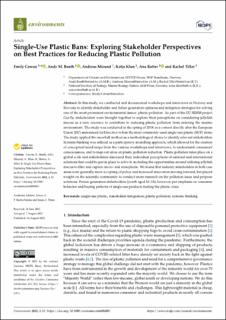| dc.contributor.author | Cowan, Emily Christine | |
| dc.contributor.author | Booth, Andrew | |
| dc.contributor.author | Misund, Andreas Ugelvik | |
| dc.contributor.author | Rotter, Ana | |
| dc.contributor.author | Klun, Katja | |
| dc.contributor.author | Tiller, Rachel Gjelsvik | |
| dc.date.accessioned | 2022-10-19T07:50:39Z | |
| dc.date.available | 2022-10-19T07:50:39Z | |
| dc.date.created | 2021-08-16T16:28:35Z | |
| dc.date.issued | 2021 | |
| dc.identifier.citation | Environments. 2021, 8 (8), 1-16. | en_US |
| dc.identifier.issn | 2076-3298 | |
| dc.identifier.uri | https://hdl.handle.net/11250/3026920 | |
| dc.description.abstract | In this study, we conducted and documented workshops and interviews in Norway and Slovenia to identify stakeholder and future generation opinions and mitigation strategies for solving one of the most prominent environmental issues: plastic pollution. As part of the EU H2020 project GoJelly, stakeholders were brought together to explore their perceptions on considering jellyfish mucus as a new resource to contribute to reducing plastic pollution from entering the marine environment. The study was conducted in the spring of 2019, in a context directly after the European Union (EU) announced its Directive to ban the most commonly used single-use plastic (SUP) items. The study applied the snowball method as a methodological choice to identify relevant stakeholders. Systems thinking was utilized as a participatory modelling approach, which allowed for the creation of conceptual mind maps from the various workshops and interviews, to understand consumers' consciousness, and to map out ideas on plastic pollution reduction. Plastic pollution takes place on a global scale and stakeholders discussed their individual perceptions of national and international solutions that could be put in place to solve it, including the opportunities around utilizing jellyfish mucus to filter and capture micro- and nanoplastic. We found that industry stakeholders in both case areas were generally more accepting of policy and increased innovation moving forward, but placed weight on the scientific community to conduct more research on the pollution issue and propose solutions. Future generation stakeholders (youth aged 14–18), however, put emphasis on consumer behavior and buying patterns of single-use products fueling the plastic crisis. | en_US |
| dc.language.iso | eng | en_US |
| dc.publisher | MDPI | en_US |
| dc.rights | Navngivelse 4.0 Internasjonal | * |
| dc.rights.uri | http://creativecommons.org/licenses/by/4.0/deed.no | * |
| dc.subject | Mikroplast | en_US |
| dc.subject | Microplastic | en_US |
| dc.subject | Plastforurensning | en_US |
| dc.subject | Plastic pollution | en_US |
| dc.subject | stakeholder inclusion | en_US |
| dc.subject | stakeholder inclusion | en_US |
| dc.title | Single-Use Plastic Bans: Exploring Stakeholder Perspectives on Best Practices for Reducing Plastic Pollution | en_US |
| dc.type | Peer reviewed | en_US |
| dc.type | Journal article | en_US |
| dc.description.version | publishedVersion | en_US |
| dc.rights.holder | Copyright: © 2021 by the authors. Licensee MDPI, Basel, Switzerland. This article is an open access article distributed under the terms and conditions of the Creative Commons Attribution (CC BY) license (https:// creativecommons.org/licenses/by/ 4.0/). | en_US |
| dc.subject.nsi | VDP::Samfunnsvitenskap: 200 | en_US |
| dc.subject.nsi | VDP::Social sciences: 200 | en_US |
| dc.source.pagenumber | 1-16 | en_US |
| dc.source.volume | 8 | en_US |
| dc.source.journal | Environments | en_US |
| dc.source.issue | 8 | en_US |
| dc.identifier.doi | 10.3390/environments8080081 | |
| dc.identifier.cristin | 1926433 | |
| dc.relation.project | EC/H2020/Grant agreement no. 774499 | en_US |
| dc.relation.project | Norges forskningsråd: 318730 | en_US |
| cristin.ispublished | true | |
| cristin.fulltext | original | |
| cristin.qualitycode | 1 | |

